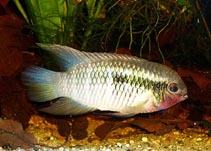| Family: |
Cichlidae (Cichlids), subfamily: Cichlasomatinae |
| Max. size: |
7.4 cm SL (male/unsexed) |
| Environment: |
demersal; freshwater; pH range: 4.4 |
| Distribution: |
South America: Rio Orinoco, rio Casiquiare and rio Negro drainages in Venezuela. |
| Diagnosis: |
Dorsal spines (total): 14-15; Dorsal soft rays (total): 9-10; Anal spines: 3-3; Anal soft rays: 8-8. Distinguished from all its congeners by the combination of the following characters: usually with 15 spines and 10 rays on dorsal fin; 23-25 scales in E1 row; dorsal fin base only moderately scaly; absence of conspicuous pattern of cross series of tiny light dots; and maximum length of 7.4 cm SL (Ref. 58749). |
| Biology: |
Prefers typical blackwater habitats with clear, acid and very soft-tea colored water. Usually found along the banks of brooks and small rivulets in areas of extremely shallow water with water depth approximately between 10 and 50 cm, where they occur either in a layer of dead leaves covering the bottom of the bank side or among submerged terrestrial vegetation (Ref. 58749). |
| IUCN Red List Status: |
Least Concern (LC); Date assessed: 20 November 2020 Ref. (130435)
|
| Threat to humans: |
harmless |
| Country info: |
|
Source and more info: www.fishbase.org. For personal, classroom, and other internal use only. Not for publication.

